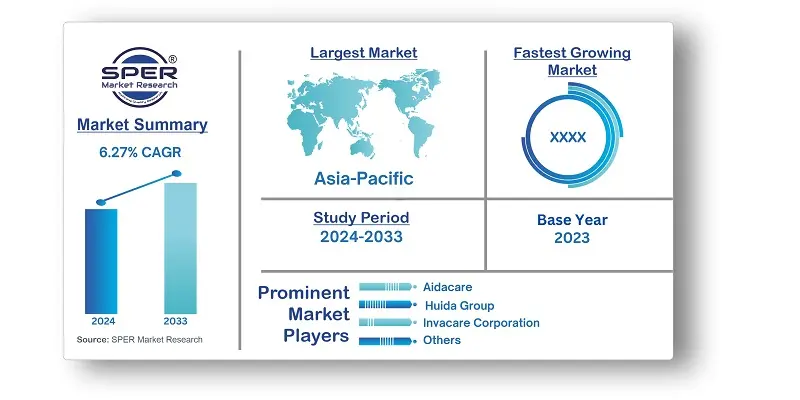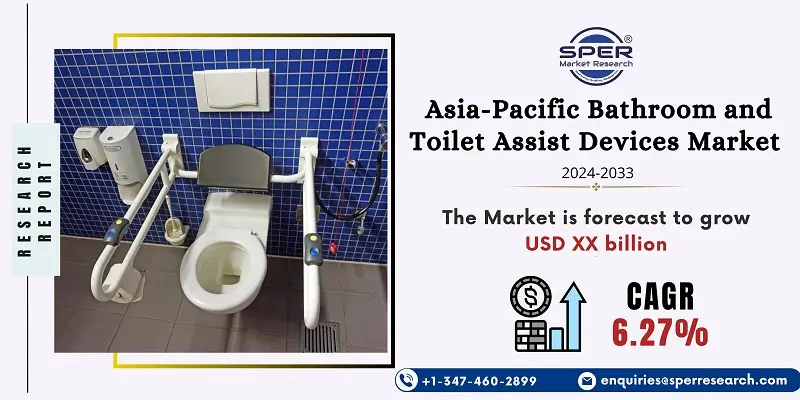
Asia Pacific Bathroom and Toilet Assist Devices Market Trends, Share, Demand and Future Outlook
Asia-Pacific Bathroom and Toilet Assist Devices Market Growth, Size, Trends Analysis- By Product- Regional Outlook, Competitive Strategies and Segment Forecast to 2033
| Published: Nov-2024 | Report ID: HLCA2488 | Pages: 1 - 157 | Formats*: |
| Category : Healthcare | |||
- Leading toilet and bidet seat manufacturer Bemis Manufacturing Company introduced a Personal Wash Bidet attachment on August 3, 2022, that is only compatible with the Clean Shield elevated toilet seat. The straightforward operation of the non-electric Personal Wash Bidet enables customers to keep their privacy and clean themselves on their own.
- Etac introduced a new type of Clean mobile shower commode chairs with a front seat opening on May 30, 2022. Users who can reach farther away from the front may find the new model appropriate, depending on their range of motion or personal taste. Some caregivers' routines may also be improved. The front opening might be particularly useful in areas where hand showers are preferred.


| Report Metric | Details |
| Market size available for years | 2020-2033 |
| Base year considered | 2023 |
| Forecast period | 2024-2033 |
| Segments covered | By Product |
| Regions covered | Australia, China, India, Japan, South Korea, Rest of Asia-Pacific |
| Companies Covered | Aidacare, Arjo, Etac, E-Z Lock, Huida Group, Invacare Corporation, Lixil Group Corporation, ProBasics, Roca, Tall-Ette, Toto Asia, and Others. |
- Elderly Individuals
- People with Disabilities
- Caregivers and Family Members
- Healthcare Facilities
- Rehabilitation Centers
- Home Healthcare Providers
- Occupational Therapists
- Government Agencies
| By Product: |
- Asia-Pacific Bathroom and Toilet Assist Devices Market Size (FY’2024-FY’2033)
- Overview of Asia-Pacific Bathroom and Toilet Assist Devices Market
- Segmentation of Asia-Pacific Bathroom and Toilet Assist Devices Market By Product (Shower Chairs and Stools, Bath Lifts, Toilet Seat Raisers, Bath Aids)
- Expansion Analysis of Asia-Pacific Bathroom and Toilet Assist Devices Market
- Problems and Obstacles in Asia-Pacific Bathroom and Toilet Assist Devices Market
- Competitive Landscape in the Asia-Pacific Bathroom and Toilet Assist Devices Market
- Impact of COVID-19 and Demonetization on Asia-Pacific Bathroom and Toilet Assist Devices Market
- Details on Current Investment in Asia-Pacific Bathroom and Toilet Assist Devices Market
- Competitive Analysis of Asia-Pacific Bathroom and Toilet Assist Devices Market
- Prominent Players in the Asia-Pacific Bathroom and Toilet Assist Devices Market
- SWOT Analysis of Asia-Pacific Bathroom and Toilet Assist Devices Market
- Asia-Pacific Bathroom and Toilet Assist Devices Market Future Outlook and Projections (FY’2024-FY’2033)
- Recommendations from Analyst
1.1. Scope of the report1.2. Market segment analysis
2.1. Research data source2.1.1. Secondary Data2.1.2. Primary Data2.1.3. SPER’s internal database2.1.4. Premium insight from KOL’s2.2. Market size estimation2.2.1. Top-down and Bottom-up approach2.3. Data triangulation
4.1. Driver, Restraint, Opportunity and Challenges analysis4.1.1. Drivers4.1.2. Restraints4.1.3. Opportunities4.1.4. Challenges4.2. COVID-19 Impacts of the Asia-Pacific Bathroom and Toilet Assist Devices Market
5.1. SWOT Analysis5.1.1. Strengths5.1.2. Weaknesses5.1.3. Opportunities5.1.4. Threats5.2. PESTEL Analysis5.2.1. Political Landscape5.2.2. Economic Landscape5.2.3. Social Landscape5.2.4. Technological Landscape5.2.5. Environmental Landscape5.2.6. Legal Landscape5.3. PORTER’s Five Forces5.3.1. Bargaining power of suppliers5.3.2. Bargaining power of buyers5.3.3. Threat of Substitute5.3.4. Threat of new entrant5.3.5. Competitive rivalry5.4. Heat Map Analysis
6.1. Asia-Pacific Bathroom and Toilet Assist Devices Market Manufacturing Base Distribution, Sales Area, Product Type6.2. Mergers & Acquisitions, Partnerships, Product Launch, and Collaboration in Asia-Pacific Bathroom and Toilet Assist Devices Market
7.1. Asia-Pacific Bathroom and Toilet Assist Devices Market Size, Share and Forecast, By Product, 2020-20267.2. Asia-Pacific Bathroom and Toilet Assist Devices Market Size, Share and Forecast, By Product, 2027-20337.3. Shower Chairs and Stools7.4. Bath Lifts7.5. Toilet Seat Raisers7.6. Bath Aids
8.1. Asia-Pacific Bathroom and Toilet Assist Devices Market Size and Market Share
9.1. Asia-Pacific Bathroom and Toilet Assist Devices Market Size and Market Share By Region (2020-2026)9.2. Asia-Pacific Bathroom and Toilet Assist Devices Market Size and Market Share By Region (2027-2033)9.3. Australia9.4. China9.5. India9.6. Japan9.7. South Korea9.8. Rest of Asia-Pacific
10.1. Aidacare10.1.1. Company details10.1.2. Financial outlook10.1.3. Product summary10.1.4. Recent developments10.2. Arjo10.2.1. Company details10.2.2. Financial outlook10.2.3. Product summary10.2.4. Recent developments10.3. Etac10.3.1. Company details10.3.2. Financial outlook10.3.3. Product summary10.3.4. Recent developments10.4. E-Z Lock10.4.1. Company details10.4.2. Financial outlook10.4.3. Product summary10.4.4. Recent developments10.5. Huida Group10.5.1. Company details10.5.2. Financial outlook10.5.3. Product summary10.5.4. Recent developments10.6. Invacare Corporation10.6.1. Company details10.6.2. Financial outlook10.6.3. Product summary10.6.4. Recent developments10.7. Lixil Group Corporation10.7.1. Company details10.7.2. Financial outlook10.7.3. Product summary10.7.4. Recent developments10.8. ProBasics10.8.1. Company details10.8.2. Financial outlook10.8.3. Product summary10.8.4. Recent developments10.9. Roca10.9.1. Company details10.9.2. Financial outlook10.9.3. Product summary10.9.4. Recent developments10.10. Tall-Ette10.10.1. Company details10.10.2. Financial outlook10.10.3. Product summary10.10.4. Recent developments10.11. Toto Asia10.11.1. Company details10.11.2. Financial outlook10.11.3. Product summary10.11.4. Recent developments10.12. Others
SPER Market Research’s methodology uses great emphasis on primary research to ensure that the market intelligence insights are up to date, reliable and accurate. Primary interviews are done with players involved in each phase of a supply chain to analyze the market forecasting. The secondary research method is used to help you fully understand how the future markets and the spending patterns look likes.
The report is based on in-depth qualitative and quantitative analysis of the Product Market. The quantitative analysis involves the application of various projection and sampling techniques. The qualitative analysis involves primary interviews, surveys, and vendor briefings. The data gathered as a result of these processes are validated through experts opinion. Our research methodology entails an ideal mixture of primary and secondary initiatives.



Frequently Asked Questions About This Report
PLACE AN ORDER
Year End Discount
Sample Report
Pre-Purchase Inquiry
NEED CUSTOMIZATION?
Request CustomizationCALL OR EMAIL US
100% Secure Payment






Related Reports
Our Global Clients
Our data-driven insights have influenced the strategy of 200+ reputed companies across the globe.






















